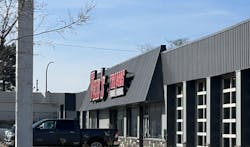Ride control has always been important to vehicle maintenance, but these services aren’t always the easiest to market to customers.
Mike Spitale, manager of the Van’s Auto Service & Tire Pros store on the east side of Akron, Ohio, says customers usually recognize when the ride of their vehicles diminishes, so they know when attention is needed.
“It’s easier to make the sale on ride control services when the customer can already feel, hear or see a problem,” says Spitale. “It’s easier to have a customer come in with a specific complaint regarding ride control and having them be able to feel or hear the difference in the ride when they drive out of the dealership” following ride control service.
That said, it’s always a good idea to fully inspect every vehicle, he adds.
Storing data
Spitale says that every vehicle that comes into Van’s Auto Service & Tire Pros gets a full vehicle inspection for free. Then Spitale and his team inform the customer of the conditions of their “wipers, battery and belts, and (we) then let them know what maintenance services we recommend.”
His shop provides “a complete, overall condition report and we do it with equipment that allows us to take photos of the vehicle and directly send those photos to the customer’s email or phone,” he says.
“This way, the customer can see what we see and have a better understanding of why we are making recommendations.”
Not every customer acts on every recommendation right away. “Most customers are happy to know what the matter is. Whether they’re going to fix it right now or not isn’t always an important thing, but at least we’ve made the customer aware that there is an issue.”
If a customer decides not to move forward with the service, Spitale stores data about the vehicle in the business’ point-of-sale system.
Spitale’s team makes a note of the declined service and the date when the customer came into the dealership. The next time the customer comes into the store, the system notifies the staff of the previously declined service and the technician can see if the customer is interested in reassessing a repair this time.
“And it could be any service that a customer is coming back in for, like an oil change or tire rotation,” says Spitale. “Once our system registers the customer, that denial of service notification will alert our technicians.”
Springtime spike
Spitale says his team sees a spike in ride control services performed once the weather starts getting a little bit warmer. “After people go through the winter hitting potholes and driving on unstable roads,
they start to notice their cars aren’t driving like before or they’re making a noise they haven’t made before.”
Listening to the customer is critical, according to Spitale. “If a customer complains of a noisy disturbance while driving, it kind of gives my guys a good idea (about) where to look and we key in on that area,” he says. “Then we take photos (and) we can go back and show the customer, ‘Look, this is what was causing that noise in your car.’”
Electronic control
Ride control components and service have become more sophisticated over time, says Spitale.
Ride control service “has been a part of car repairs for over 100 years, so it’s nothing new.” For the most part, components like shocks and struts still look the same and still attach to the car the same way. But a lot of the newer vehicles have electronic ride control features.
“So in those cases, it’s an advanced shock or strut going on the vehicle and when you’re dealing with that, it’s about a $1,000 to $1,500 higher cost than regular struts and shocks.”
About the Author
Madison Hartline
Associate Editor
Madison Hartline (Gehring) is the associate editor for Modern Tire Dealer and Motor Age. Since joining MTD after graduating from The Ohio State University in 2022, she has taken on the role of managing the brand’s social media strategy, producing podcast episodes and overseeing eNewsletter content.
Don't miss Hartline's next article. Sign up for MTD's newsletter.

